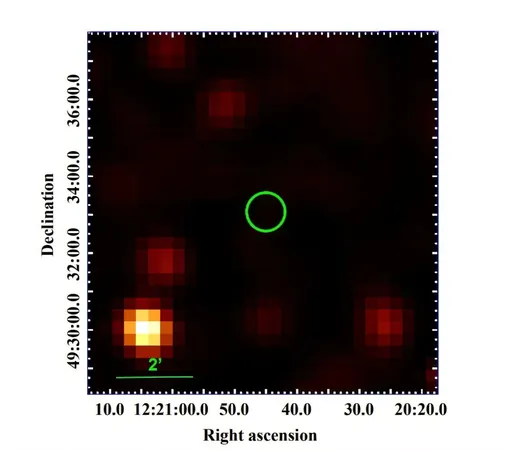
Astonishing Discovery: Two Luminous Flares Erupt from Nearby Tidal Disruption Event!
2025-01-02
Author: Daniel
Astonishing Discovery of Tidal Disruption Event ASASSN-22ci
A team of astronomers has made an astonishing discovery involving a recently identified tidal disruption event (TDE) known as ASASSN-22ci, unleashing two brilliant flares from a supermassive black hole. This groundbreaking finding was detailed in a paper published on December 19 on the preprint server arXiv, sparking excitement within the astronomical community.
What is a Tidal Disruption Event?
Tidal disruption events occur when a star ventures perilously close to a supermassive black hole, succumbing to the intense tidal forces that rip it apart. This disintegration results in stellar debris cascading toward the black hole, releasing radiation from the innermost regions of the accreting matter—clear signs of a TDE at play. The collision of these debris streams generates energy dissipation, potentially forming an accretion disk around the black hole.
Details of ASASSN-22ci
The event ASASSN-22ci, also referred to as AT2022dbl, was first spotted in February 2022 by the All-Sky Automated Survey for Supernovae (ASAS-SN). It resides in the nucleus of a galaxy named WISEA J122045.05+493304.7, situated at a redshift of approximately 0.0284.
Observations and Findings
Following the discovery, Jason T. Hinkle from the University of Hawaii and his team employed various observatories like the Zwicky Transient Facility (ZTF), Asteroid Terrestrial Impact Last Alert System (ATLAS), and ASAS-SN to conduct detailed spectroscopic and photometric observations. Their efforts led to the remarkable detection of two distinct flares emanating from ASASSN-22ci.
Characteristics of the Flares
Remarkably, the researchers noted that each flare registered a scorching temperature of around 30,000 K, with a rising time of roughly 30 days. The peak bolometric luminosity ranged between an astounding 200 to 1,000 tredecillion ergs per second! Furthermore, both flares exhibited a blue optical spectrum featuring broad emission lines of hydrogen, helium, and nitrogen. The second flare erupted about 720 days after the first, generating significant intrigue.
Intriguing Predictions
Interestingly, pre-discovery surveys have eliminated the possibility of earlier flares occurring in the last 6,000 days, indicating that the first flare likely marked the inception of the TDE. The researchers predict that another flare from ASASSN-22ci may emerge around February 4, 2026, making astronomers keenly watchful for this next event.
Significance of the Discovery
This discovery positions ASASSN-22ci among only five TDEs known to emit multiple flares, providing researchers with a unique opportunity to study the mechanics of tidal disruption phenomena. The superior multiwavelength photometric data and high signal-to-noise optical spectroscopy captured during the flares set this TDE apart from others.
Future Research Directions
Hinkle and his team's study opens the door for significant exploration into the theoretical implications surrounding these astronomical events. "Despite the small sample size of five optically-selected TDEs exhibiting multiple flares, it is sufficient to begin unraveling the mysteries connected to these spectacular incidents," concluded the researchers.
Conclusion
As we delve deeper into the enigma of black holes and their voracious appetites, the revelations from ASASSN-22ci may provide crucial clues to the formation and evolution of these cosmic giants. Stay tuned for the next astonishing chapter in the saga of the universe!


 Brasil (PT)
Brasil (PT)
 Canada (EN)
Canada (EN)
 Chile (ES)
Chile (ES)
 Česko (CS)
Česko (CS)
 대한민국 (KO)
대한민국 (KO)
 España (ES)
España (ES)
 France (FR)
France (FR)
 Hong Kong (EN)
Hong Kong (EN)
 Italia (IT)
Italia (IT)
 日本 (JA)
日本 (JA)
 Magyarország (HU)
Magyarország (HU)
 Norge (NO)
Norge (NO)
 Polska (PL)
Polska (PL)
 Schweiz (DE)
Schweiz (DE)
 Singapore (EN)
Singapore (EN)
 Sverige (SV)
Sverige (SV)
 Suomi (FI)
Suomi (FI)
 Türkiye (TR)
Türkiye (TR)
 الإمارات العربية المتحدة (AR)
الإمارات العربية المتحدة (AR)